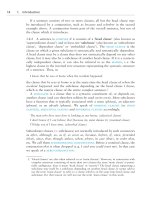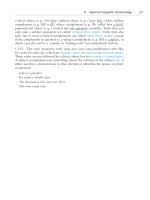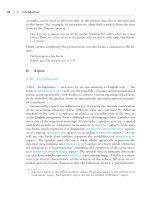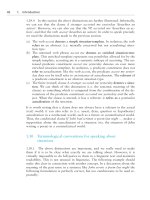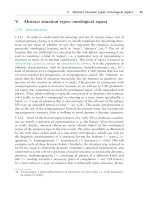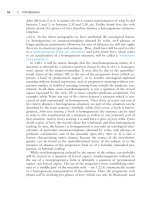The grammar of the english verb phrase part 17 pdf
Bạn đang xem bản rút gọn của tài liệu. Xem và tải ngay bản đầy đủ của tài liệu tại đây (63.35 KB, 7 trang )
I. Introduction 105
In conclusion, our ‘future tense’ will cover not only the ‘pure future’ inter-
pretation but also the ‘prediction’ sense and the ‘predictability’ meaning of will.
2.8.3 It is clear from 2.8.1 and 2.8.2 that we agree that there is an epistemic
modal aspect of meaning in the future tense,
6
and that we assume that will-
forms with the weak or strong epistemic connotation of pure future, prediction
or predictability can all be treated as future tense forms. In doing so we follow
Declerck (1991: 87), who argues that the use of will for predictability Ϫ a use
which is traditionally treated as modal rather than temporal Ϫ can in fact be
analysed as the use of future tense will in order to put the ‘temporal focus’ on
a future time of evaluation. The idea of ‘temporal focus’ will be dealt with at
length in 11.1Ϫ3, but is in fact clear from the following examples:
I spoke to the foreigner in French because he didn’t understand English. (The for-
eigner presumably still does not understand English, so the speaker could have used
doesn’t understand. Using the past tense, however, he focuses on the time when he
spoke to the foreigner rather than on t
0
.)
Bill finally saw the town, which lay in a wide valley. (The town still lies in that
valley, but putting the temporal focus on the past time when Bill saw the town is a
means of representing things as Bill experienced them, i. e. from his point of view.)
I {need / will need} a stamp for this envelope. (With will need the speaker focuses
on the future time when he will make the envelope ready to be sent off.)
These examples show that tense forms can reflect a choice, not only of tempo-
ral location of a situation relative to another time, but also of point of view
(temporal focus). Predictability will can be explained similarly as a result of
putting the temporal focus on a future time of evaluation:
They will be across the border by now.
(when the bell rings) That will be the milkman.
This car will have cost a good deal, I suppose.
These uses of will can be explained as cases in which the temporal focus is
shifted from the present to the future. Instead of simply claiming that a situa-
tion is actualizing at t
0
, the speaker suggests that it will become apparent in
the future that the situation was actualizing at his present t
0
. That is, the
speaker takes a future time of orientation (rather than t
0
) as the time at which
the truth of the statement is evaluated. Needless to say, the idea of a future
evaluation time is essential to these uses of will. Sentences like those above are
6. Epistemic modality has to do with the speaker’s expression of the degree to which he
thinks a statement is true. A statement can be represented, e. g. as likely (He may well
do it), as possible (He might do it), as contrary-to-fact (He might have done it). The
epistemic modality expressed by the future tense is the idea ‘not-yet-factual at t
0
’ (see
14.4.2): the future situation is not yet a fact at t
0
, when the prediction is made.
106 2. Towards a theory of tense and time
not interpreted as asserting a fact, but rather as expressing a belief which is
expected to be confirmed in the future. That’ll be the milkman implies some-
thing like ‘as you will see when you open the door’. Such a temporal, rather
than modal, analysis of will accords with the fact that the French future tense,
which does not involve the use of an auxiliary, can be used in exactly the same
way: Ce sera le laitier [‘It will be the milkman’].
2.9 Future tense forms vs ‘futurish’ tense forms
Some forms in English have dual time reference: forms such as be about to, or the
present progressive in I’m leaving in a minute, or, in some of its uses, be going to refer
to the time of an implied present state (which is one from which a future outcome can
be predicted) as well as to the time of a future situation. It is the actualization of the
future situation which is the outcome predictable from the present state. Only the
future situation Ϫ the one associated with the lexical verb Ϫ is actually referred to.
Such verb forms establish a future domain but are not future tense forms. We call them
futurish forms. ‘Be going to ϩ verb’ may be a futurish form and it may be a future
tense form, depending on whether it has ‘pure future’ time reference or also implies a
present state. (There is no clear cut-off point between the two uses.)
2.9.1 Apart from the future tense, which (from a temporal point of view)
does no more than locate a situation in the future and which therefore has
‘single time reference’ (i. e. future time reference only), there are also verbal
expressions which would seem to effect ‘dual time reference’, viz. a combina-
tion of future time reference and present time reference. Such expressions will
be referred to as
futurish tense forms. These forms link the future actualiza-
tion of a situation to a particular kind of present state. For example:
[I have bought a computer because] I am going to write a novel. (ϭ ‘I have the
present intention of writing a novel in the future.’)
[Look at those clouds!] There is going to be a storm in a minute. (ϭ ‘There are signs
in the present that there will be a storm soon.’)
I’m leaving in a minute. (ϭ ‘There is a present arrangement for me to leave in
a minute.’)
[Look at her!] She is about to faint. (ϭ ‘You can see now that she will faint in the
very near future’.)
The Queen is to leave for Canada tomorrow. (ϭ ‘There is an official decision that
the Queen will leave for Canada tomorrow.)
In the last three examples, the forms am leaving, is about to faint and is to
leave will not be treated as lexical realizations of the future tense. However,
I. Introduction 107
they are ‘futurish’ forms because they clearly locate the situation of leaving or
fainting in the future (and in doing so establish a future ‘temporal domain’ Ϫ
see 2.15).
As to be going to, this auxiliary has two uses when it is used in the present
tense: one as a futurish form, in which its primary meaning has to do with
present factors, such as present intention, as in I’m going to pick the lock, and
one as a future tense form, in which its primary meaning is simply future time
reference, as in Tomorrow the weather’s going to be better than it’s been today.
In the first function it parallels other futurish forms like am leaving, whose
primary meaning is present time reference. In the second function it parallels
will (as future tense auxiliary), which simply expresses future time reference Ϫ
see 2.9.2. The only difference is that be going to is less grammaticalized as a
marker of future tense than will is, since it is more frequently found with
predominantly present time reference. (Though there are clear enough exam-
ples of futurish be going to and clear enough examples of future tense be going
to, there are of course intermediate cases that do not fall so clearly into the
one or the other sort of be going to.)
The observation that futurish forms link the future actualization of a situa-
tion to a present state and therefore have ‘dual time reference’ does not mean
that they refer to two different situations (one present, the other future). Only
lexical verbs can denote situations. All the futurish forms contain only one
lexical verb, which refers to the situation that is located in the future. In this
respect a sentence like I’m going to help her differs from (the semantically
similar) I intend to help her, which involves two lexical verbs and therefore
refers to two different situations.
2.9.2 In English, the prototypical realization of the future tense involves will
(or, in the first person, shall). However, as we have seen above, the auxiliary
be going to can sometimes also express ‘pure future’, which means that we
must recognize ‘be going to ϩ present infinitive’ as a possible (albeit less proto-
typical) realization of the future tense. In the following examples there is no
real difference of meaning between will and be going to:
Tomorrow there {will be / is going to be} frost in the northern part of England.
{Will she be / is she going to be} there? I wonder.
How many of these animals {will survive / are going to survive} winter is anybo-
dy’s guess.
Our decision to treat such be going to-forms as (less prototypical) lexical real-
izations of the future tense is in keeping with (some of) the literature: in spite
of the fact that be going to and will/shall are not always interchangeable, some
researchers have argued that they do have the same basic temporal meaning.
After investigating the use of the future tense and the go-future in a variety of
108 2. Towards a theory of tense and time
languages, Fleischman (1982: 97) concludes that her findings “militate strongly
in favour of regarding the go-paradigm as a legitimate future-tense form”.
Haegeman (1989: 291) similarly argues “that at the level of sentence meaning
be going to and shall/will are equivalent, and that the difference between them
is to be found in the constraints they impose on the processing in context of
the utterance in which they occur”.
The claim that the will/shall future tense is more prototypical than the be
going to future tense accords with the following observations. First, in Standard
English, the future perfect is nearly always formed with shall and will, very
seldom with be going to (as future tense form) and never with a futurish
form. Compare:
John {will take / is going to take / is taking / is about to take} the bus in five minutes.
John {will have taken /
?
is going to have taken / *is having taken / *is about to have
taken} the bus by the time we reach his office.
Secondly, shall and will are the auxiliaries that combine with a progressive
infinitive to form progressive future tense forms. Progressive future tense forms
built with be going to are very seldom used and are restricted to an informal
register:
This time tomorrow I {will /
??
am going to} be driving to London.
2.9.3 In sum, we will work with the following assumptions:
(a) There does exist a future tense in English. This tense has future time refer-
ence only.
(b) English also has ‘futurish’ forms. These have dual time reference in the
sense that, semantically, they link the future actualization of a situation to
a present state.
(c) The prototypical realization of the future tense is by means of will / shall.
A secondary, less prototypical realization of the future tense is by means
of be going to. The latter can also be used as part of a futurish form.
2.10 Does English have a present perfect tense?
Some authors consider that the English present perfect is not a separate tense, but is
rather a combination of another tense (present or past) and an aspectual meaning
component of ‘current relevance’. However, since we analyse the present perfect as
having a tense structure different from that of the present tense or the past tense, we
consider it to be a tense in its own right. The present perfect locates a situation in the
I. Introduction 109
pre-present zone while the past tense locates it in the past zone. The claim that the
present perfect has a different temporal structure from the past tense is supported by
the fact that the two tenses behave differently with certain adverbs. (In chapter 6 it
will be shown that certain adverbials referring to a time that is connected to the present
combine with the present perfect but not with the past tense, and that adverbials refer-
ring to a bygone time that is dissociated from the present combine with the past tense
but not with the present perfect.)
2.10.1 It is often claimed that a form like has arrived is not a present perfect
tense form but rather expresses ‘perfect aspect’. In this view there is no present
perfect tense in English. The so-called ‘present perfect’ is claimed to be a combi-
nation of a genuine tense (the present tense for some, the past tense for
others Ϫ see below) and a special kind of aspect, viz. ‘perfect aspect’, which is
expressed by have … -en. The meaning of ‘perfect aspect’ is defined in terms
of ‘current relevance’ (i. e. the anterior situation referred to by have … -en is
still relevant at the time to which it is represented as anterior), which is some-
times narrowed down to ‘resultant state’: John has arrived represents John’s
arrival as still relevant at t
0
, or expresses the resultant state ‘John is here’. This
definition of the present perfect is essentially aspectual: the perfect focuses on
the fact that the situation is finished and on the ensuing resultant state (in the
same way as the progressive focuses on the middle of a situation).
It is striking, however, that there is no unanimity as to which ‘genuine’
tense Ϫ present or past Ϫ is realized by forms like has come. Whereas some
linguists (e. g. Palmer 1988: 35) claim that the present perfect is a combination
of the present tense with ‘perfect aspect’ (or ‘perfect phase’), others (e. g. Com-
rie 1985: 78) claim that the present perfect realizes the same temporal structure
as the preterite and differs from the latter only in that it also expresses ‘perfect
aspect’ (defined as ‘current relevance’). These claims cannot both be true. In
fact, we will argue in 5.1Ϫ2 that the present perfect minus ‘perfect aspect’
yields neither the temporal schema of the present tense nor that of the preterite.
The present perfect realizes a temporal structure of its own, and should there-
fore be considered a tense in its own right.
2.10.2 In 2.33Ϫ37 we will argue that the preterite, the present perfect tense
and the present tense locate the time of the situation referred to in three dif-
ferent ‘time-zones’, viz. the ‘past’, the ‘pre-present’ and the ‘present’. (The past
is conceived of as lying completely before t
0
and as disconnected from it; the
pre-present is conceptualized as a period leading up to t
0
; the present zone is
restricted to t
0
itself.) Since these are three different ways of locating a situation
in time, the three forms represent three different tenses Ϫ see the definition of
‘tense’ and ‘tense forms’ in 2.1 and 2.3.
110 2. Towards a theory of tense and time
The choice between locating a situation in the past and locating it in the
pre-present is determined by whether the speaker is concerned with ‘THEN’
or ‘NOW’. Concern with NOW is equivalent to ‘current relevance’ Ϫ see 5.35,
(but not necessarily to ‘present result’ Ϫ see 5.36). We therefore agree with the
claim that the present perfect expresses current relevance, but do not see this
as evidence for the claim that the present perfect is not a tense. The present
perfect is a tense because, by locating a situation in the pre-present rather than
the past or present, it expresses a temporal structure which is different from
the semantic structure of any other tense.
The above view is consistent with the fact that the past tense, the present
perfect tense and the present tense differ as to their compatibility with adverbs
like still or already. This shows that the meaning of the present perfect is
neither ‘past tense ϩ current relevance’ nor ‘present tense ϩ current relevance’.
It was five o’clock. John {was still / *has still been} in his office.
It is five o’clock. John {is still / *has still been} in his office.
It was five o’clock. John {was already / *has already been} in his office.
It is five o’clock. John {is already / has already been} in his office. (If the present
perfect is substituted for the present tense, we do not arrive at a meaning which is
a combination of the meaning of the present tense and current relevance. Rather,
the time reference of the clause is completely different: John’s being in his office
precedes speech time rather than coinciding with it.)
Clearly, the present perfect has a temporal meaning (semantic structure) of
its own.
2.11 More on the notion of temporal zero-point (t
0
)
Although the temporal zero-point (t
0
) is nearly always speech time, in certain contexts
it is possible for the speaker to choose the decoding time as t
0
. (For example, this is
the case when a road sign reads You are now entering Washington County). Whether
t
0
is the encoding time or the decoding time, English treats it as a point (rather than
an interval). Thus, durative situations cannot be located in their entirety at t
0
.
2.11.1 In 2.4 we have defined t
0
as the time which is the ultimate ‘origin’ of
all the temporal relations expressed by the temporal structure of a tense, i. e.
the only time in a tense structure that is not itself represented as dependent on
another (more basic) time. We have said that t
0
is the only time that is always
given (‘assumed known’) when a sentence is uttered. We have also noted that
in English the temporal zero-point is nearly always the encoding time, i. e. the
I. Introduction 111
time of uttering or writing the message. In this section we will explain why t
0
is only ‘nearly always’ the encoding time: when the time of decoding (ϭ hearing
or reading) the message is later than the encoding time, it is possible for the
speaker to choose the decoding time as temporal zero-point.
7
The following are
some typical examples in which the speaker makes use of the latter possibility:
(a) Suppose you go to someone’s office and find a note on his door saying I
am in room 21. In this case the time referred to by the present tense is not
the time when the message was written but the time at which the message
was expected to be read and interpreted. (If the note said I have gone to
room 21 the same remark would be applicable.) Road signs of the kind
You are now leaving East Sussex constitute similar examples.
(b) Most newspaper articles are written the day before the newspaper is on
sale to the public, or earlier. In such cases, writers may use a tense system
in which t
0
is not the time when the articles are written but the time of
publication.
At the time of going to press, the two parties were still not decided as to whether
the meeting should take place. (www) (If t
0
were the author’s speech time, the
appropriate form would be are still not decided.)
The following example shows that this choice of t
0
is not obligatory:
At time of going to press, this software (named ‘PaTrAS’) is in the final stages of
testing and should be available to a small group of users for field trials early in
the new year. (www)
However, t
0
has to be the decoding time if there is a temporal adverb whose
interpretation is shifted to the point of view of the reader. Thus, if someone
dies on 23 July this may be reported (in a text written the same day for publica-
tion on 24 July) as Yesterday X died, but not as *Yesterday X dies. Note that
in this case the journalist selects as t
0
the official date of publication, since it
is expected that most of the public are going to read the paper that day. Who-
ever reads the paper after that date must therefore compute the absolute deictic
indications of time (i. e. the deictic adverb yesterday and the deictic tense form
died) from the temporal standpoint of this publication time.
7. This double possibility concerning the choice of t
0
(temporal deictic centre) runs parallel
with the double choice that is sometimes possible in connection with the spatial deictic
centre. For example, verbs like come and bring allow the spatial deictic centre to lie
either with the speaker or with the addressee:
(i) “Come and stay for the weekend and bring the children.” Ϫ “Thanks, we’d love to
come. Can we bring the dog too?”
In the first sentence, come and bring imply movement towards the speaker’s deictic
centre. In the reply they imply movement towards the addressee’s deictic centre.



